Table of contents
- Large-displacement four-cylinder from BMW, Honda, Kawasaki, Suzuki and Yamaha In-line four-cylinder motorcycles
- BMW K 1300 R – the most modern
- Kawasaki’s ZRX 1200 – the oldest
- Honda CB 1300 – the quietest
- Suzuki B-King – the most powerful
- Suzuki Bandit 1250 – all-round harmonious
- Yamaha XJR 1300 – classic, timeless, elegant
- All too difficult across the board
- MOTORCYCLE conclusion
- Technology in detail: the inline four-cylinder
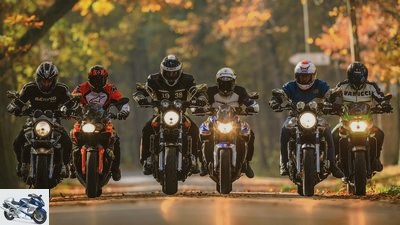
jkuenstle.de
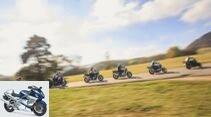
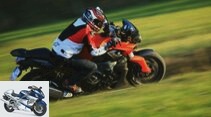
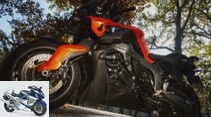
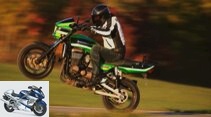
17th pictures
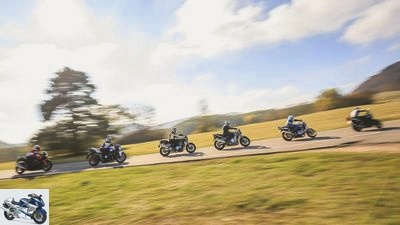
jkuenstle.de
1/17
BMW K 1300 R, Honda CB 1300, Kawasaki ZRX 1200 R, Suzuki Bandit 1250, Suzuki B-King and Yamaha XJR 1300 in comparison.
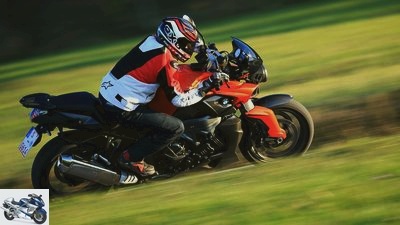
jkuenstle.de
2/17
BMW K 1300 R.
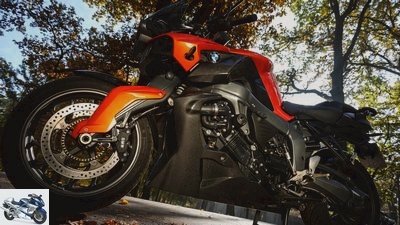
jkuenstle.de
3/17
Telelever, Paralever, ESA. 1300 sports engine. A brutal techno-naked.
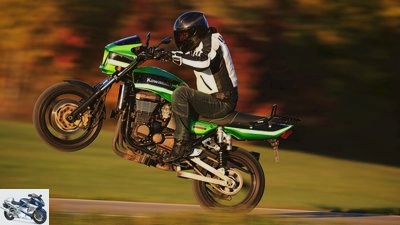
jkuenstle.de
4/17
Kawasaki ZRX 1200 R.
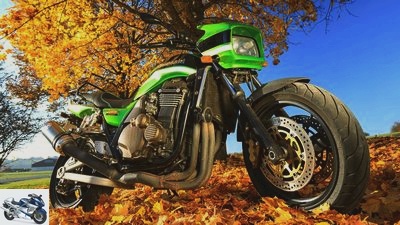
jkuenstle.de
5/17
Rocky. Smoky. Old but never boring. Udo Lindenberg?
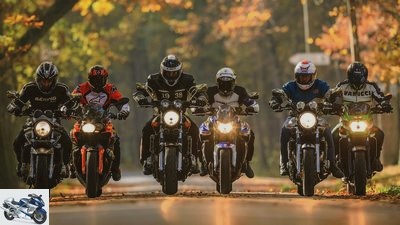
jkuenstle.de
6/17
BMW K 1300 R, Honda CB 1300, Kawasaki ZRX 1200 R, Suzuki Bandit 1250, Suzuki B-King and Yamaha XJR 1300 in comparison.
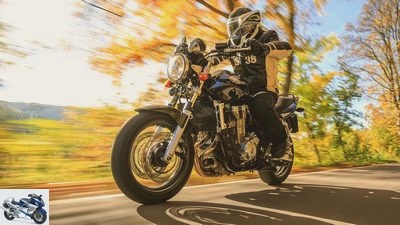
jkuenstle.de
7/17
Honda CB 1300
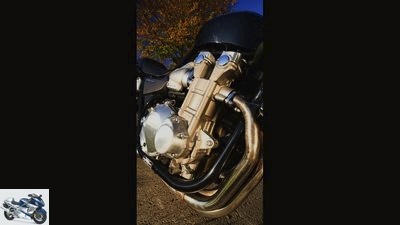
jkuenstle.de
8/17
Statesmanlike sophistication. The most typical Honda of all Hondas.
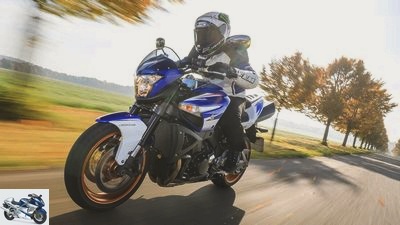
jkuenstle.de
9/17
Suzuki B-King
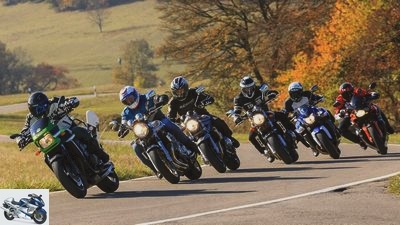
jkuenstle.de
10/17
BMW K 1300 R, Honda CB 1300, Kawasaki ZRX 1200 R, Suzuki Bandit 1250, Suzuki B-King and Yamaha XJR 1300 in comparison.
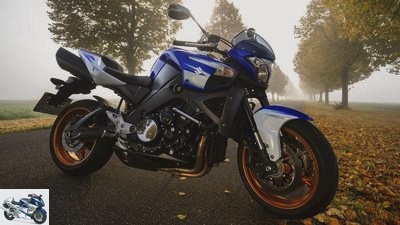
jkuenstle.de
11/17
Iron fist in a velvet glove. Underrated. Hail to the King, baby.
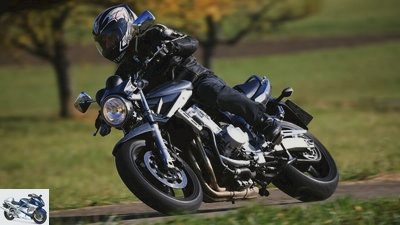
jkuenstle.de
12/17
Suzuki Bandit 1250
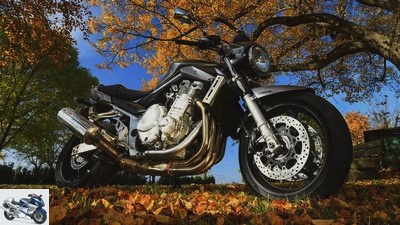
jkuenstle.de
13/17
All pressure on the people! Nowhere is there more torque for less.
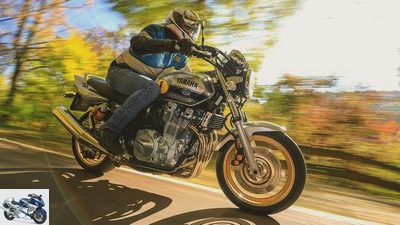
jkuenstle.de
14/17
Yamaha XJR 1300
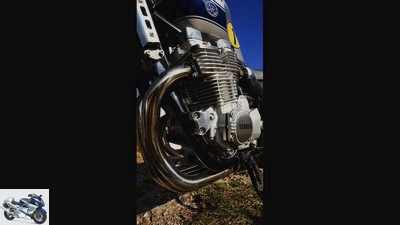
jkuenstle.de
15/17
You can’t get more timeless. And yet, now is the time for the XJR to say goodbye.
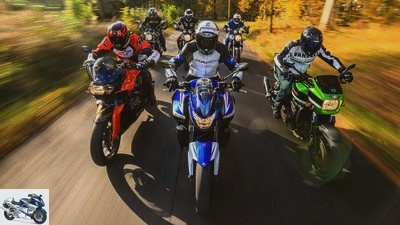
jkuenstle.de
16/17
BMW K 1300 R, Honda CB 1300, Kawasaki ZRX 1200 R, Suzuki Bandit 1250, Suzuki B-King and Yamaha XJR 1300 in comparison.
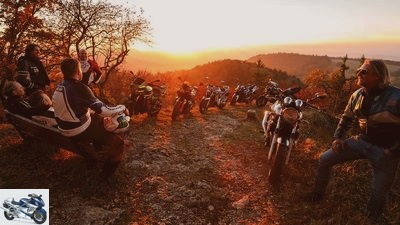
jkuenstle.de
17/17
BMW K 1300 R, Honda CB 1300, Kawasaki ZRX 1200 R, Suzuki Bandit 1250, Suzuki B-King and Yamaha XJR 1300 in comparison.
motorcycles
In-line four-cylinder motorcycles in comparison
Large-displacement four-cylinder from BMW, Honda, Kawasaki, Suzuki and Yamaha
In-line four-cylinder motorcycles
For four decades, full-capacity in-line four-cylinders have confidently moved the motorcycle world with dignified pressure. But their autumn seems to have come, the last of their kind will soon be disappearing. And it’s not just the bad Euro 4 to blame. Quo vadis, big foursome?
Johannes Muller
11/24/2016
Unbelievable. Six machines on photo production – and none of them, civilly moved, are noticed by rowdy exhaust sounds. Six times no banging, crackling, roaring, screeching. Convertible drivers calmly wave past us, cyclists smile – and even greet the mushroom pickers. Instead, six times evenly full-sonorous hum from the evenness of a Japanese Zen garden. Is that peace and quiet, or will they soon fall asleep, the large inline four-cylinder BMW K 1300 R, Honda CB 1300, Kawasaki ZRX 1200 R, Suzuki Bandit 1250, Suzuki B-King and Yamaha XJR 1300?
Buy complete article
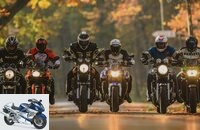
Large-displacement four-cylinder from BMW, Honda, Kawasaki, Suzuki and Yamaha
In-line four-cylinder motorcycles
12 pages) as PDF
€ 2.00
Buy now
How you feel about it has to be left to the personal taste and mind of each driver. But this is undisputed: the in-line four-cylinder has shaped the recent history of the motorcycle like no other engine concept. It was the Inline-Four that let the motorcycle outgrow the dirty corner at the beginning of the seventies. When Soichiro Honda first presented the CB 750 Four, that pioneering, epoch-making Japanese four-car, to the world in 1969, motorcycles were viewed as jerky, oily, slow or mostly broken. The original “superbike” became the measure of all things and the blueprint for all successors and imitators who increased and refined this basic concept. Japan has shown the world that performance, durability and smoothness can be brought under one roof. In the four-cylinder. He started a huge triumphal march. The six-transmitter never really caught on, and the Japanese liked to serve the power-hungry customers of that time with ever newer, larger, ever stronger row fours. For decades, the Inline-Four was the industry standard in affordable motorcycle construction, the highest-displacement variants at the same time its crowning glory.
Everything in the past. At some point there was enough power, others were lighter and more compact. The V2 became durable and cultivated. The three-cylinder came back and made many friends. And today, instead of the large 1200, 1300 and 1400 series, 1000 cc four-cylinder units derived from the sports models can be found everywhere, also as V4s or pseudo-V4s. The thick inline four-cylinder with conventional firing order and correct displacement are out. Euro 4 does the rest. For the last remaining machines on the market, the technically feasible retrofitting is not worthwhile, most of them are being phased out. Occasion for a small retrospective in which we bring together six style-forming representatives of the same genre. What are they telling us? What is it that makes it so attractive? Maybe they are just out of date?
Subscribe to MOTORCYCLE videos on Youtube
BMW K 1300 R – the most modern
Let’s look at them one by one. The BMW K 1300 R, until recently with its S and GT sisters still in the white-blue range, represents the most current and at the same time most extraordinary design in this sextet. Telelever at the front, cardan with Paralever at the rear, ESA chassis , Partly integral ABS, automatic switch. A real techno motorcycle, especially when it comes to the engine. Almost lying down, valves operated by rocker arms far down in the vehicle, compression ratio of 13: 1, turns up to 11,000 – a contemporary sports engine, only with a 30 percent increase in displacement. That’s what BMW does K 1300 R a weapon, especially because the bolt-stable chassis with an eternally long wheelbase allows acceleration and braking orgies to be completed without any hint of unicycle acrobatics.
The engine of the BMW K 1300 R pushes wonderfully meaty from moderate revs, then unleashed, and finally merciless. Always gladly illustrated by the following value: 0-200 in 7.9 seconds. Okay, with a sonorous humming it has little to do with it in this mode, and this 1300 actually belongs to the rough legs. Tingly, almost a little impatient for the next acceleration fireworks, he’s hanging on the gas. It combines the superior speed of a large four-wheeler with the explosiveness of a sports engine. As a K unit in an unconventional but highly functional chassis. Extremely attractive, special – and perhaps not the typical figurehead for the Big Four due to the steep purchase price of up to 17,000 euros.
Kawasaki’s ZRX 1200 – the oldest
At the other end of the spectrum sits Kawasaki’s ZRX 1200, here in a tasteful R version with a rectangular lamp cover. It was already retro when the term wasn’t as ubiquitous in the motorcycle world as it is today. The bow to Eddie Lawson’s AMA Superbike and the bad boy image are included. The oldest bike here. No ABS, telescopic fork, carburetor – old-school technology and old-school driving experience. It feels analogous, the ZRX. In and of itself bearish, but in a field of bulls then initially and subjectively a bit behind. Until you prick the bear and let the aisles stand. Then you can feel the sporty genes of the old GPZ engine base with every additional rotation of the crankshaft. Later than Honda and Yamaha and much, much later than a bandit, the rocker delivers its maximum torque. The Kawa seems absolutely indestructible, which is also confirmed by the sometimes astronomical mileage of machines for sale on the network. The inline four-cylinder as a loyal companion in a lime-green version with snotty-smoky Udo Lindenberg charm. This is what the ZRX 1200 conveys.
Honda CB 1300 – the quietest
If you only look at the key data, you could Hondas CB 1300 see close to the Kawa: similar peak performance, comparable maximum torque, only a little heavier. But he would be completely wrong, the two worlds separate in character. Beefy, broad-banded, silky smooth, almost free of vibrations and load changes, the Honda unit pushes, and in the last gear you can even stroll through 30 km / h zones. The CB 1300 is perhaps the most typical of all Hondas. Motor, clutch, gearbox, brake – everything polished down to the smallest detail. Get on, engage fifth gear, feel good. After a few hundred meters, the pilot’s heart rate drops and levels off at idle speed. This is also underlined by the engine sound. Like a monk in deep meditation, the Big Block Honda hums itself right into the brain stem, exuding an unprecedented calm. Complete harmony also when it comes to driving behavior. Neutral turning, sensitive cushioning – despite the heavy metal weight of 262 kilos. The Honda surprises with its agility – like a sumo wrestler. The inline four-cylinder as a precision engineering masterpiece.
Suzuki B-King – the most powerful
The Suzuki B-King apparently has nothing to do with such restraint. Why, too: Suzuki promised 184 hp for the bare Hayabusa offshoot built from 2007 to 2011, but we still found a sufficient 174 on the test bench. Those who mess with such a pound in terms of output don’t need to look behind the mountain either – the Manga design, especially the steeply towering rear end with the two huge exhaust trombones, is still a topic of conversation at the gas station today. The other way around: It’s not the exhaust that is too big, but the rear wheel that is too small. A tire in 240 / 50-19 dimensions, and the proportions were right.
Much more important than any questions of taste: of all the inline four-cylinder engines gathered here, the B-King unit is the most powerful. Subjectively, its 1340 reactor is a bit more typhoon-like, more unstoppable than the K-BMW, even if objectively – this is due to the very long final gear ratio and an electronic throttle in the lower gears – white-blue just wins in terms of performance. What the BMW cannot do, however, is to conceal this elemental force in such a statesmanlike manner. The Suzuki has a wonderful performance curve, runs smoother, responds smoother to gas commands, sounds more discreet – only to ignite very calmly and terribly if necessary. No 1000 engine can do that, no matter how short it is. Like its peregrine falcon sister Hayabusa, the B-King is an iron fist in a velvet glove. Pure sovereignty, effortless superiority. Hail to the King, baby.
You knew that or you could expect it. What the B-King surprises with, however, is its absolutely sociable, predictable nature. It rides smoothly and smoothly on well-coordinated, high-quality chassis components for a heavy motorcycle. It also weighs, but especially it hides this very skillfully. B-King: individual over foursome, already a classic, underestimated.
Suzuki Bandit 1250 – all-round harmonious
What one cannot necessarily say about the Suzuki Bandit 1250. The quality of the Bandit 1250, just like that of its air / oil-cooled bestseller predecessor, the 1200, can be summed up in a simple formula: There is practically no more torque per euro. The last Euro 3 copies are currently being sold for well under 9,000 euros. In return, you get an indestructible four-cylinder in-line, which provides its maximum torque of 114 Nm at a very, very early 3,500 revolutions. Driving the Bandit 1250 is sluggish torque surfing – all day, every day. Even more than the other five. The fact that the 1255 does a shift at 6,000 tours – a gift, because by then it has done its job. It doesn’t take more. A different exhaust should still help.
But even outside of the engine, Suzi likes Carefree. Functional, solid home-style cooking with the chassis and brakes, a cozy place for the driver and pillion passenger, foolproof driving behavior – all-round harmonious. All torque to the people, that could be the motto of the Suzuki Bandit 1250. The in-line four-cylinder as an accelerator of the masses.
Yamaha XJR 1300 – classic, timeless, elegant
Like Bandit and ZRX, the one looks too Yamaha XJR 1300 looks back on a long history. Presented in 1995 as the 1200, it grew to the 1300 in 1999. She carries the last, largest air-cooled row quad, the roots of which are somewhere in the XJ 1100, under the tank. Finely ribbed, as it should be for such an engine – far from all superlatives. Classic, timeless, elegant, with the wonderful stereo suspension struts and especially in the color variant we drive with golden wheels. It’s almost a fine irony that the XJR is running out now, of all times, when the whole world is crying out for simple, unaffected motorcycles. On the other hand, the XRJ is definitely not for attention-seeking hipsters. Rather for calm connoisseurs. This quad also depends very well on the gas. Tame, but emphatically, he also pushes under a diplomatically discreet exhaust note. The driving behavior is also rather tranquil. Of course you can drive quickly with an XJR, but with a little sluggish understeer it always makes it clear that it wants to roll more. Shift lazy gliding, the XJR leaves you in peace. The large four-cylinder as a decelerator, as a soul kneader.
All too difficult across the board
Too many trite phrases and platitudes? Pretty much everything has been said about these classics over the years. So what is the bottom line of tangible findings? First of all, our trip is divided into two groups. BMW K 1300 R and Suzuki B-King are the modern, sporty ones among the large four-wheelers. High compression, high revving, highly potent. They show off their superior motor power. Which, however, and this is the essential thing, is not bought at the price of hectic greed for revs or uneven running, but is presented in a civilized, cultivated and polished manner thanks to the power of displacement and the magic of mass balance. Even more so with the famous Suzuki B-King than with the brute, technocratic, rough BMW K 1300 R..
On the other hand are the classic, timeless Big Four. Kawasaki ZRX 1200 R, Honda CB 1300, Suzuki Bandit 1250 and Yamaha XJR 1300 are gourmet machines. With all the sometimes clear differences in detail, the driving experience on them is fundamentally very similar. Dignified performance, full thrust, uncapricious nature. What they all have in common is that, with their uncomplicated, elastic drives, they leave space for the essentials: namely, driving. Shift lazy delegate torque in high gear, no chopping, no rattling. Clean lines, calm, round boots. Something for connoisseurs, without a doubt. But in the time when many look at the image when riding a motorcycle and scramble after the difficult-to-grasp experience value, such inactive understatement bikes are a thing of the past. Robustness, smooth running, real pressure from below, subtle exhaust sound – at a time when normal Otto riders drive less and less, perhaps still chasing a handful of tank fillings through the nozzles a year, such old virtues are just no longer in demand. It should rock, that’s understandable. Peace and quiet of the large four-cylinder – a discontinued model?
Autumn is also a little homemade. Because no matter how well some of them like to drive, they are far too difficult across the board. That is not God given. With the exception of the BMW, the pounds of which are due to the dimensions and the chassis concept, all of these machines are partly ancient technology. Engines, whose roots go back to the original years outlined at the beginning, of massive construction, with appropriate frames. Heavy metal from the time when iron was still cheap. No wonder that none of these rather simple machines falls below five quintals. They don’t have to – but a different approach would also be conceivable. How could it look? A specially designed, modern engine with 1300, why not 1400 cubic, compact, light and quiet. Perhaps 140 HP that will last forever, full of torque. Not hectic, but potent. The one in a fresh, sporty naked bike chassis. Payable. No high end, no frills, but not too difficult. 220 kilos should be feasible. Would that be something?
MOTORCYCLE conclusion
Rest in peace, big four-cylinder? It’s funny that this groundbreaking concept, yesterday the industry standard and measure of all things, seems out of fashion today. Big bikes have become a little victim of their own success and the spirit of the times. Today everyone has performance, increasingly also running smoothness and durability. Many buyers are currently asking for robust, emotional little cylinders instead of introverted, feel-good understatements. You should really think about the big four-cylinder in a completely new, very fresh way. Perhaps it would then be again above the 1000 cubic sound barrier: four wins.
Technology in detail: the inline four-cylinder
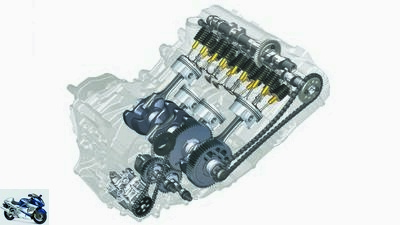
jkuenstle.de
The in-line four-cylinder with conventional crank pin offset (in the picture BMW K 1200) offers many advantages in terms of concept.
Even if other engine concepts have attracted more attention recently, the in-line four-cylinder offers many advantages. If you also provide it with a full displacement, you get an extremely confident drive.
The most obvious of these advantages is first of all the excellent mass balance of an inline four cylinder. With a conventional crank pin offset of 180 degrees (see sectional drawing), the inertial forces and moments of inertia due to the opposing pistons (1 and 4 as well as 2 and 3 run in parallel) largely cancel each other out. In contrast to a V-engine, for example, the four pistons fire at an even distance of 90 degrees, distributed over 360 degrees of crankshaft rotation. The result is basically a very round, low-vibration run. Only a six-cylinder can do better, but it is usually wider, requires more parts and is therefore heavier and more expensive to manufacture. A positive side effect is better durability, because fewer vibrations also mean less wear. Smaller individual cubic capacities also benefit the longevity of the drive, which can also be driven at low speed thanks to the even firing sequence. Compared to two or single cylinders that require third or even second gear in urban areas, inline fours do this exercise effortlessly in high gear. This also means less switching work in general. However, this does not say anything about the design of a unit. Like all engines, a four-cylinder can also be “pointed”, i.e. designed for maximum performance, or for good pulling power, ie pressure at low speeds. The machines represented here generally tend, unlike the extreme 600 super athletes, for a moderate vote.
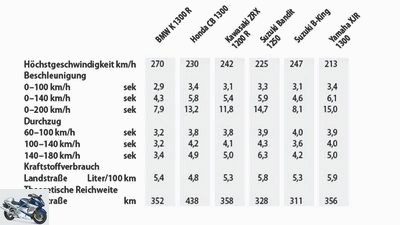
Not too short stroke, rather low compression, with (presumably) long intake paths and rather tame control times. Thanks to the very large displacement, the result is good peak performance with excellent torque in the lower speed range. BMW K 1300 and Suzuki B-King, however, are a bit out of line. They have a modern design, short-stroke, high-compression. The result is astonishing for both: They offer enormous pressure and a lot of revving with explosive power even in the lower revs. It is true that the top performance of modern 1000 series engines with super sports origin, as they are installed in similar concepts, is more than sufficient. But because these were designed to be more extreme in accordance with their original use, they offer significantly less pressure in the lower speed range, as the comparison between the Suzuki GSX-S 1000 and B-King shows. At 6,000 rpm, the B-King delivers a whopping 30 hp more, it also has the much nicer torque curve. Today’s 1000s often buy good drafts with a very short translation – this in turn comes at the expense of sovereignty and consumption.
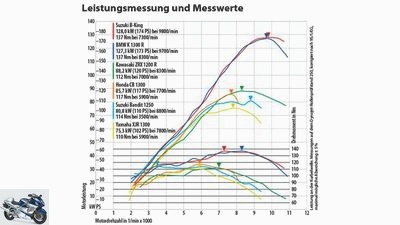
The power and torque diagrams of our six test machines can be divided into two groups. First the “classic” Motors of an older origin or type. The XJR, CB 1300 and ZRX 1200 draw very similar curves up to about 7000 revolutions. Around 100 Nm is a real benchmark in the two-wheeled world at such low speeds. From then on, the Kawa accelerates again, which helps it to achieve a higher peak performance, but is of secondary importance in everyday life. The Bandit 1250 impresses with a very early applied maximum torque. Turbodiesel character – turning it further does not help. On the other side K 1300 and B-King. They have a bit more cubic capacity and are more modern and sporty in design. At the very bottom the Bandit can keep up well, but from around 3500 revs both disappear into other spheres. It is noteworthy that both curves are almost identical. The B-King, however, has a long gear ratio and does not release full power in the lower gears. The K 1300 can save this throttle thanks to traction control.
Related articles
-
48 hp motorcycles 300 cc entry level comparison test 2018
Rossen Gargolov 23 pictures Rossen Gargolov 1/23 Right in the middle of the golden October. Rossen Gargolov 2/23 The test field consists of entry-level…
-
Comparison test: 600 super sports car, four-cylinder, two-cylinder
Jahn motorcycles Comparison test: 600 super sports car, four-cylinder, two-cylinder Comparison test: 600 super sports car, four-cylinder, two-cylinder…
-
125cc motorcycles in a comparison test
Bjoern grams 28 pictures Bjoern grams 1/28 On the small eight-liter excursion, we compare the concepts: roadster, athlete, retro bike and supermoto!…
-
Comparison test: Japanese naked bikes
Jahn motorcycles Comparison test: Japanese naked bikes Comparison test: Japanese naked bikes Go big Content of …or go home! Big bore instead of boring,…
-
New Supersport Motorcycles 2015 Technology Comparison – Part 1
Photos: Manufacturer 16 pictures manufacturer 1/16 At Aprilia everything is different: the V4 spreads its cylinders at a 65-degree angle in order to save…
-
Technology comparison of new supersport motorcycles 2015 – part 2
MOTORCYCLE 30th pictures manufacturer 1/30 Aprilia RSV4 RR. Aprilia is still quite stingy with pictures of the new RSV4 RR. manufacturer 2/30 Kawasaki…
-
The best-selling motorcycles of 2008
Jahn motorcycles The best-selling motorcycles of 2008 The best-selling motorcycles of 2008 Five top sellers and their owners Regardless of the market…
-
48 hp motorcycles in used advice
viperagp – Fotolia / MOTORRAD 20th pictures Artist 1/20 A Harley Sportster 883 is only slightly above the A2 limit with an open 53 HP, a circumcision…
-
Motorcycles not coming in 2007
11 pictures Yamaha 1/11 Yamaha 2/11 Yamaha 3/11 Yamaha 4/11 Yamaha 5/11 Say 6/11 Yamaha 7/11 Yamaha 8/11 Yamaha 9/11 Yamaha 10/11 Yamaha 11/11…
-
Comparison test: Honda CBF 1000 Silverline, Suzuki Bandit 1250 S, Yamaha FZ1 Fazer
Jahn 22nd pictures Honda 1/22 Honda CBF 1000 Honda 2/22 Honda CBF 1000 Zdrahal 3/22 Presentation at the fair in Paris. Honda 4/22 Honda CBF 1000 Honda…